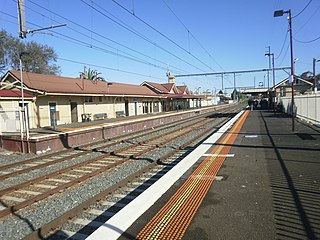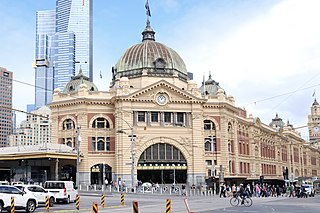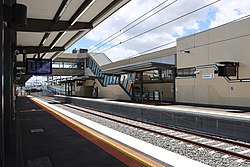
The City Loop is a piece of underground commuter rail infrastructure in the central business district (CBD) of Melbourne, Victoria, Australia.

Hawksburn railway station is a commuter railway station located in the southern Melbourne suburb of South Yarra in Victoria, Australia. Hawksburn is a below ground unstaffed station, featuring four platforms with an island platform and two side platforms accessible by a pedestrian bridge. The station is listed on the Victorian Heritage Register, and was opened on 7 May 1879.

Toorak railway station is a commuter railway station on the northern boundary of Armadale, a suburb of Melbourne, Victoria, Australia. The station is listed on the Victorian Heritage Register, and was opened on 7 May 1879. The station is named after the nearby suburb of Toorak—located north of the station. The station consists of an island platform and two side platforms all accessed by a pedestrian bridge. There are two principal station buildings located on the central platform and on platform 4, consisting of a small two and one-story brick buildings. These buildings were provided in 1914, as ticketing and staff offices. The station is only partially accessible due to a multiple steep access ramps.

Armadale railway station is a commuter railway station in Armadale, a suburb of Melbourne, Victoria, Australia. The station is listed on the Victorian Heritage Register and was opened on 7 May 1879. The station consists of an island platform and two side platforms, all accessed by a pedestrian bridge. There are two principal station buildings located on the central platform and on platform 4, consisting of a small two and one-story brick buildings. These buildings were provided in 1914 as ticketing and staff offices. The station is only partially accessible due to a multiple steep access ramps.

Malvern railway station is a commuter railway station that is part of the Melbourne railway network in Victoria, Australia. The station is located on the southern border of Malvern, a suburb of Melbourne, and was opened on 7 May 1879. The station complex consists of an island platform and two side platforms all accessed by a pedestrian bridge. There are two red brick Edwardian-era station buildings, constructed in 1914 as ticketing and staff offices. The entire complex is listed on the Victorian Heritage Register because of its architectural significance and its role in the development of Malvern as a significant metropolitan centre. The station is only partially accessible because of multiple steep access ramps.

Caulfield railway station is a commuter railway station on the northern boundary of Caulfield East, a suburb of Melbourne, Victoria, Australia. Opened in 1879 and rebuilt from 1913 to 1914, the station complex is listed on the Victorian Heritage Register and is noted as an example of Federation Free Style architecture. It is named after the nearby suburb of Caulfield, located southwest of the station.

Glen Huntly railway station is a commuter railway station located in the south-eastern suburb of Glen Huntly in Melbourne, Victoria, Australia. The station had various forms of the name Glen Huntly, which it initially opened as "Glen Huntly Road" upon its opening in 1881. It was renamed to Glen Huntly a year later on 1 September 1882, it was then renamed to "Glenhuntly" on 20 April 1937. It was given its current name to "Glen Huntly" on 13 April 2023 as part of the Level Crossing Removal Project. Glen Huntly is a below ground host station, consisting of three platforms, a single island platform with two faces and a single side platform, connected by staircases, lifts and a ground level concourse on Glen Huntly Road. The station was previously at ground level upon its opening on 19 December 1881 until 31 March 2023; however, in July 2023, a new below ground station was provided and rebuilt as part of the Level Crossing Removal Project.

Mentone railway station is a commuter railway station on the Frankston line, which is part of the Melbourne railway network. It serves the south-eastern suburb of Mentone, in Melbourne, Victoria, Australia. Mentone station is a below ground premium station, featuring two side platforms. It opened on 19 December 1881, with the current station provided in 2020.

Mordialloc railway station is a commuter railway station on the Frankston line, which is part of the Melbourne railway network. It serves the south-eastern suburb of Mordialloc, in Melbourne, Victoria, Australia. Mordialloc station is a ground level premium station, featuring two side platforms. It opened on 19 December 1881.

Edithvale railway station is a commuter railway station on the Frankston line, which is part of the Melbourne railway network. It serves the south-eastern suburb of Edithvale, in Melbourne, Victoria, Australia. Edithvale station is a ground level unstaffed station, featuring two side platforms. It opened on 20 September 1919, with the current station provided in 2021.

Proposals for expansion of the Melbourne rail network are commonly presented by political parties, government agencies, industry organisations and public transport advocacy groups. The extensions proposed take a variety of forms: electrification of existing routes to incorporate them into the suburban rail system; reconstruction of former passenger rail lines along pre-existing easements; entirely new routes intended to serve new areas with heavy rail or provide alternative routes in congested areas; or track amplification along existing routes to provide segregation of services. Other proposals are for the construction of new or relocated stations on existing lines, to provide improved access to public transport services.

The Pakenham line is a commuter railway line on the Melbourne metropolitan railway network serving the city of Melbourne in Victoria, Australia. Operated by Metro Trains Melbourne, the line is coloured light blue and is one of the two lines that constitute the Caulfield group. It is the city's longest metropolitan railway line at 57 kilometres (35 mi). The line runs from Flinders Street station in central Melbourne to East Pakenham station in the south-east, serving 27 stations via South Yarra, Caulfield, Oakleigh, and Dandenong.

The Sandringham line is a commuter railway line in the city of Melbourne, Victoria, Australia. Operated by Metro Trains Melbourne, it is the city's fourth shortest metropolitan railway line at 17.9 kilometres (11.1 mi). The line runs from Flinders Street station in central Melbourne to Sandringham station in the south-east, serving 14 stations via South Yarra, Balaclava, Elsternwick, and Brighton. The line operates from approximately 5am to 12am, daily, with 24 hour service available on Friday and Saturday nights. Services run every 7–8 minutes during peak hour, with services running every 15 minutes during the inter-peak period on weekdays, and every 20 minutes at night and during the day on weekends. Additionally, services run every 60 minutes overnight on Friday and Saturday nights as part of the Night Network. Trains on the Sandringham line run with a two three-car formations of Comeng or Siemens Nexas trainsets.

The Cranbourne line is a commuter railway line in the city of Melbourne, Victoria, Australia. Operated by Metro Trains Melbourne, it is the city's second longest metropolitan railway line at 44 kilometres (27 mi). The line runs from Flinders Street station in central Melbourne to Cranbourne station in the south-east, serving 24 stations via the City Loop, South Yarra, Caulfield, Oakleigh, and Dandenong. The line operates for approximately 20 hours a day with 24 hour service available on Friday and Saturday nights. During peak hour, headways of up to 5 to 15 minutes are operated with services every 15–20 minutes during off-peak hours. Trains on the Cranbourne line run with a seven-car formation operated by High Capacity Metro Trains.

The Werribee line is a commuter railway line in the city of Melbourne, Victoria, Australia. Operated by Metro Trains Melbourne, it is the city's ninth longest metropolitan railway line at 32.9 kilometres (20.4 mi).

The Williamstown line is a commuter railway line in the city of Melbourne, Victoria, Australia. Operated by Metro Trains Melbourne, it is the city's third shortest metropolitan railway line at 16.2 kilometres (10.1 mi).

The Melbourne rail network is a metropolitan suburban and freight rail system serving the city of Melbourne, Victoria, Australia. The metropolitan rail network is centred around the Melbourne central business district (CBD) and consists of 221 railway stations across 16 lines, which served a patronage of 182.5 million over the year 2023–2024. It is the core of the larger Victorian railway network, with regional links to both intrastate and interstate rail systems.

The Stony Point line is a commuter railway line in the outer metropolitan area of Melbourne, Victoria, Australia. Operated by Metro Trains Melbourne, it is the city's only diesel service on the metropolitan network and the tenth longest line at 31 kilometres (19 mi). The line acts as an extension of the Frankston line with services running from Frankston station to the small town of Stony Point in the south-east, serving 10 stations via Leawarra, Baxter, Hastings, and Bittern. The line operates for approximately 13 hours a day, unlike other lines on the network, which provide 24-hour service on Friday and Saturday nights. Headways of 90 to 120 minutes are operated throughout the day due to limited patronage and infrastructure constraints. Trains on the Stony Point line run as two one-car formations of V/Line Sprinter DMUs.

The Craigieburn line is a commuter railway line in the city of Melbourne, Victoria, Australia. Operated by Metro Trains Melbourne, it is the city's seventh shortest metropolitan railway line at 27.0 kilometres (16.8 mi). The line runs from Flinders Street station in central Melbourne to Craigieburn station in the north, serving 21 stations via North Melbourne, Essendon, and Broadmeadows. The line operates for approximately 19 hours a day with 24 hour service available on Friday and Saturday nights. During peak hour, headways of up to 5 minutes are operated with services every 20–30 minutes during off-peak hours. Trains on the Craigieburn line run with a two three-car formations of Comeng or Siemens Nexas trainsets.
The Mornington railway line, in Melbourne, Australia, was a rural railway branching off from the Stony Point railway line at Baxter. The line had a life of 92 years, opening in 1889, and closing in 1981.































